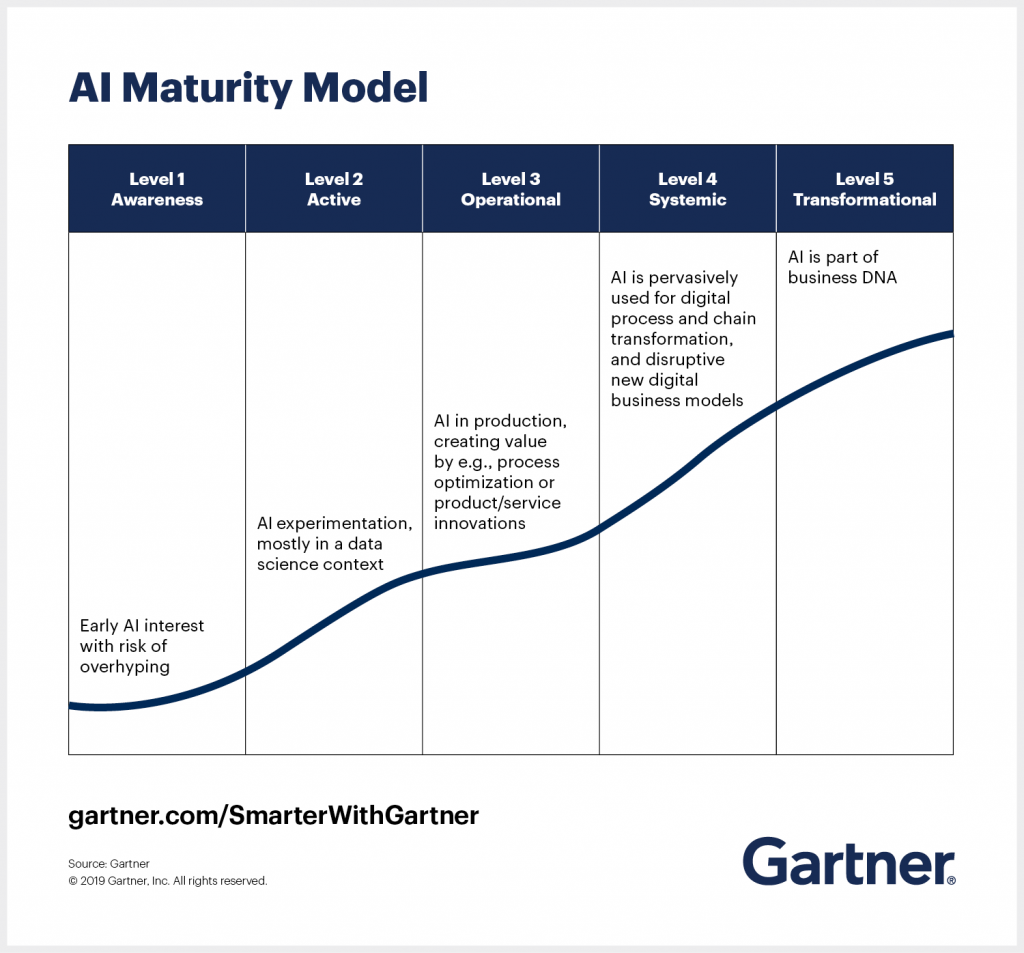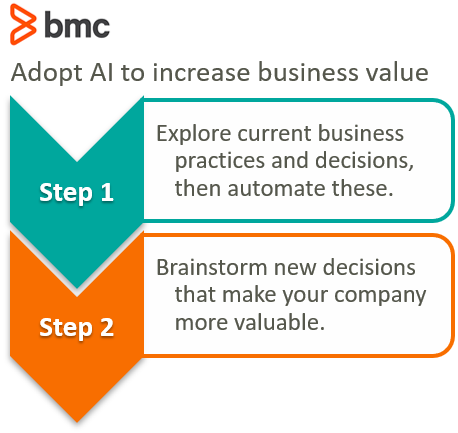Gartner’s AI Maturity Model: Maximize Your Business Impact


AI is known as artificial intelligence. Assessing its value is notoriously tricky, for many reasons. To do this, it’s better to think of AI not as artificial intelligence—but as Advanced Information Processing. It is the same AI everyone has come to know, but when thought of as information processing, we can view the technology as a tool rather than another thinking species. With tools, we gain the agency to create new things.
In this article, I’m exploring how companies use AI in different stages—the AI maturity model. I also look at problems that AI can solve and ways to adopt AI, so you can mature your AI strategy and application.
Machine learning algorithms help process data in novel ways impossible to achieve before. The mathematics has been there for years, but the lack of data and compute power rendered it unviable.
Today, of course, that’s changed. Machine learning opens the possibility to collect enormous amounts of more data because it can both:
Advanced information processing—the tool that helps us measure AI strategically—brings new value to companies. The key to remember is that AI is Advanced Information Processing. Different companies will use its tooling differently. Not every company can utilize it the same. For example, AI holds greater value to companies that manage lots of information, and less to those who do little.
That’s why we have different stages of AI that companies enter into. Learn more about how Artificial Intelligence for IT Operations is making waves in streamlining IT operations for organizations worldwide.
A data maturity model is a framework that organizations can use to assess capabilities in a specific area. It describes phases or stages of a capability’s development, efficiency, or sophistication. Companies use maturity models to plan investments, improve processes and areas of competence, and make strategic changes.
Every model is different, but in general, most follow these typical levels:
Industries that have adopted the maturity model approach are those in technology and IT, healthcare, manufacturing, and financial services.
Companies will use AI in different ways. Gartner has released an AI maturity model that segments companies into five levels of maturity regarding an organization’s use of AI.
 Most companies today fall under Level 1 Awareness—their businesses only benefiting mildly from AI Few companies are in Level 5, and few are both ready and have the capacity to integrate AI through every one of their processes.
Most companies today fall under Level 1 Awareness—their businesses only benefiting mildly from AI Few companies are in Level 5, and few are both ready and have the capacity to integrate AI through every one of their processes.
At each stage in Gartner’s maturing model, a company has a different approach to A.I:
Companies in this stage know about AI but haven’t quite used it yet. These companies may be excited to implement AI They often speak more of it than they know. They formulate ideas, but not strategies, for how to use AI in their businesses.
These companies are playing with AI informally. They are experimenting with AI in Jupyter notebooks, and they may have implemented a few models from the TF.js library into their processes.
These companies have adopted machine learning into their day-to-day functions. Likely, they have a team of ML engineers. They could be maintaining models or creating data pipelines or versioning data. They have the ML infrastructure set up, and they are using ML to assist with some information processing tasks—hence the Artificial Information Processing approach to measuring value.
These companies are using machine learning in a novel way to disrupt business models. Often, hype at the awareness stage can say that they are disruptive, but the difference between a Level 1 and a Level 4 company is that the Level 4 company has feet on the ground, with the ML infrastructure in place.
Companies at this level of Gartner’s data maturity model use ML pervasively. Machine learning and information processing is the value offering towards their customers.
Companies in this stage rely on AI to do significant heavy lifting for the business. Google is an information processing company. Facebook ranks status posts and advertisements. Amazon, Netflix, Yelp recommend products, movies, and restaurants to users. All of these companies use Machine Learning to tweak their own algorithms, adjust their product offering, optimizing their systems infrastructure (i.e., Netflix experiences low latency in specific time zones).
Adopting AI shouldn’t be a move organizations take on just because it’s buzzy. Any AI adoption should provide strategic, measured value to the business. Questions to ask:
AI is useful when making data-driven decisions. Your company must be able to do this single thing very, very well if it wishes to get the most out of AI.
 Adopting AI is an ongoing two-step process: exploring current practices and brainstorming new decisions to up your company value. It works when the data is collected, and a decision needs to be made. If you have the data, then what decision can be made from it? If you make decisions, what data is necessary to make that decision? Finally, how can you start looking at every daily activity as a data-driven decision?
Adopting AI is an ongoing two-step process: exploring current practices and brainstorming new decisions to up your company value. It works when the data is collected, and a decision needs to be made. If you have the data, then what decision can be made from it? If you make decisions, what data is necessary to make that decision? Finally, how can you start looking at every daily activity as a data-driven decision?
That’s why we have different stages of AI that companies enter into. See how BMC Service Management now offers Generative AI Solutions to help enhance the AI maturity of your organization.
Begin by exploring the business for areas it can use AI Even if the task seems remedial and so easy that it doesn’t need to be automated, automation is more valuable in the long term.
When a person doesn’t have to make the same decision over and over, they are mentally freed to make other decisions. Over time, practicing automation allows the same team to run many different processes, with continued growth, instead of maxing out their mental capacity to solve the same problem over and over. Without automation, the only option for growth is hiring more team members.
After current business processes are examined, it’s time to begin thinking about new ways the organization can conduct its business. When figuring it out, the center point of attention—all your attention—should revolve around data-driven decision-making.
For example, look at your sales team. AI can be used to help a sales team segment their customers into types. A sales agent benefits by selecting the type of the customer to better negotiate a deal or offer the appropriate services. AI can take in data like customer age, email, location, purchasing habits, user habits, and use something like a K-means clustering algorithm to place the users into types. Often, as the story goes, the AI can be better at doing this than the sales agent. Talent scouts in Moneyball thought they knew a good player when they saw one, but, when it came to the data, the algorithms were able to do it better.
Not only could the AI do this better, but the sales team’s time is freed to move its attention to something else. With the team’s mental capacity freed from having to dance through pleasantries with their customers around all types, they can use the AI to assist in the type recognition, and now flood their mind with performing other higher-level tasks, like refining the product offering for a particular type. When that can be automated, the sales team can move its attention to something else, it gets automated, and so on…
Sales teams, through the use of AI, get to become developers. They stack process on top of process to allow AI to become their personal Sales Agent Assistant. Get lazy. Allow software to do more and more of the work.
AI can help any organization make decisions. Here are some examples:
For more on this topic, browse the BMC Machine Learning & Big Data Blog or read these articles: